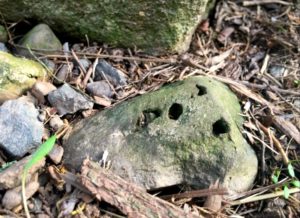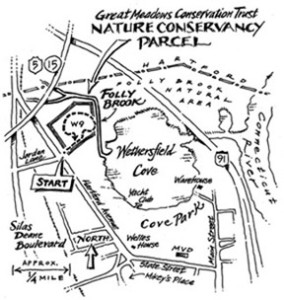Land • Walks
What makes one place different from the next is valuable. Problem is, most times residents get immune to the amazing sights, landforms, and geography of the place in which they live. Some don't though.
The city of Meriden is ringed by ancient rock ridges, offering spectacular vistas even as far south as Long Island Sound, north to Mount Tom (on a clear day). This is a place like no other.
Much of the traprock contained in the belly of the mountain is also economically lucrative, hence the traprock quarrying. Is there room for both?
Walter Hubbard, industrialist and philanthropist, left a multi-park greenspaces for his beloved city, and placed a hewn-of-stone tower on the top of a ridge that overlooks Hubbard Park. There are some places on earth that cannot be re-created. This is one of them.
The economic value of these natural wonders is a long-term draw for visitors, hikers, tourists, who will trek from across the state, region, or globe – if they know about it.
Case in point: A keen-eyed observer spotted what looked like tracks during an excavation for a state building – experts were called in. Long story short, those imprints were part of an extensive dinosaur footprint trackway that is now Dinosaur State Park. The park's 200-million-year-old sandstone trackway is a Registered Natural Landmark. (Just look at the guestbook signatures and home of origin for the global reach of this place; or ask about the international guests who plan trips to see this natural phenomenon.)
– Quarries in the Lava Beds at Meriden, Conn. By William Morris Davis, 1896
Are the traprock ridges as a whole a possible nominee for recognition as a national treasure? Just try to think of another location which has these ancient features – lava flows frozen in time, high rocky outcrops that can be reached in a short hike (not hours), panoramic views that include a “sleeping giant” formation to the south – all within a drivable, walkable area with plenty of side attractions – regional food, notable history, parks, shopping.
One of the trails (steep climb) at Guiffrida Park leads to Chauncey Peak for breathtaking views of Meriden, Higby and Lamentation Mountains, a former dairy farm, acres and acres of sky. But the path leading across the crest that takes a walker on to the back trails of the park skirts ongoing quarrying operations nibbling at the mountain. To the left as you walk, woods and earth; to your right – a steep, deep open pit that will make your stomach drop. It's edging closer to the ridge top trail.
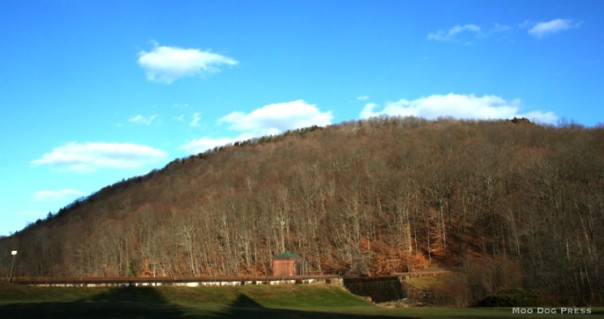
Chauncey Peak is out of the picture to the extreme right side of this image of the Guiffrida Park dam in Meriden, Conn., but behind the mountain seen here is an open quarry. The Chauncey Peak trail skirts the excavations and gives a view of the negative space.
The geology in this region is fascinating. The ties to business and a history of manufacturing, less evident.
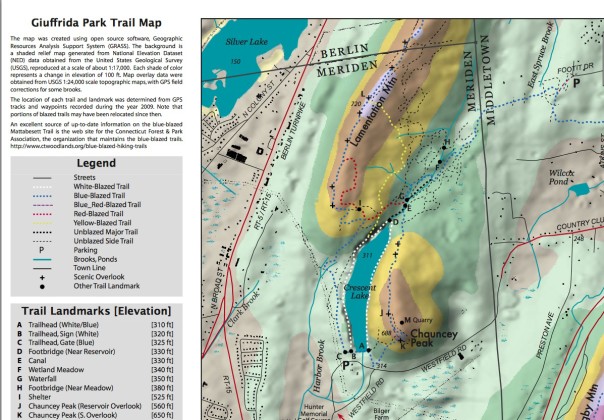
The Meriden Land Trust topographical map shows the elevation of the peak and other features. Image is linked to the land trust page for complete trail maps and information
“Thus we can account for the numerous high trap ridges such as Higby or Besick (sic) Mountain, east of Meriden Chauncy Peak and Lamentation to the northeast the Hanging Hills, and other equally prominent ridges further north and south, all of these being the edges of a single heavy lava flow repeated in as many blocks more or less dislocated. Here we find the evidence of the great original area of the main sheet.
“The course of the dislocations or faults by which the blocks are separated is about North 6o East in the Meriden region, for example, the fault that cuts off the south end of the quarry ridge north of the Fair Grounds (no longer there) in Meriden the easternmost member of the Hanging Hills group passes obliquely across the Beaver Pond valley and cuts off the northern end of Lamentation Mountain.
“At the quarry one may pass in a few steps from the main sheet to a bed of conglomeratic sandstone that belongs perhaps two thousand feet lower down in the normal series merely by crossing the branch railroad track. Following the line of the track northeastward successive conglomerate ridges may be seen to end one after another as they run north to the invisible fault line and the anterior trap ridge of Lamentation disappears in the same manner a manner that would be mysterious enough if it were not so systematically connected with the prevailing structure of the region faults of the same kind may be traced through Cat Hole Reservoir Notch and other passes that interrupt the range north of West Peak also through the notch between Lamentation Mountain and Chauncy Peak and between the latter and Higby Mountain.
“In every block thus defined the whole series of deposits must appear. The lower conglomerates and sandstones, first, then the anterior trap sheet the shales overlying it the main trap sheet forming the dominating ridges and behind these more shales and a posterior trap sheet somewhat thinner than the anterior.
“The ash bed that is associated with the anterior sheet in the Lamentation block can be seen in the same relative position in the Chauncy (sic) Peak block and again near the north end of the anterior ridge of the Higby Mountain block. It may yet be found elsewhere. It is in this structural relation that the ash bed has its highest value.”

Transactions of the Scientific Association, Meriden, Conn., by Scientific Association (Meriden, Conn.), published 1885.
– Chris Brunson
 Now on to more places to walk, explore, take your family for an outing:
Now on to more places to walk, explore, take your family for an outing:
Should anyone in your family love dinosaurs and/or geology, hit the trail to explore dinosaur-themed attractions on the Dino Trail, which links up the Connecticut Science Center in Hartford with the Yale Peabody Museum in New Haven, Dinosaur State Park in Rocky Hill, Lake Compounce in Bristol and The Dinosaur Place in Oakdale. Admission varies.
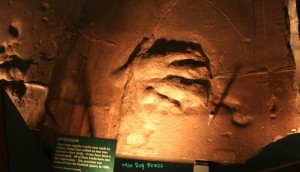
Otozoum tracks even have skin impressions. These are on display at Dinosaur State Park and were removed from the Portland Quarry in 1896.
In Rocky Hill, trails at the state park are open, free. There is a small admission fee charge to the geodesic dome exhibit area for the trackway – well worth the price. The displays inside tell a story of the geological marvels that created the region and this trackway (the prints look so recent that it appears the creatures just wandered off.) Also, see the park's web site for details on how to cast your own dinosaur track to take home – warm weather only – there is a list supplies provided.
Trails of the Sleeping Giant Park can help you unwind and wear out your canine companion (always on a leash, please). Find the park at 200 Mount Carmel Ave., Hamden, Connecticut. Visit sgpa.org to preview the trails – or print out a map.
Walk a trail of the Great Meadows Conservation Trust in and around Wethersfield. Self-guided jaunts are possible anytime, but if you want background information or a map for a place to begin, check out this link to the group's site. Group walks and events are listed there too. Consider a visit to the Eleanor Buck Nature Center, a gem of a collection named for a most talented artist, naturalist and author.
Connecticut Audubon Society at Pomfret offers guided hikes, naturalist lessons; small fee. Call (860) 928-4948 for details or visit ctaudubon.org for information about offerings at various locations.
The New England Botanical Club, founded in 1895, promotes the study of plants of North America, especially the flora of New England and adjacent areas. To view a list of field trips (2015), here is a link to their page.

